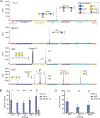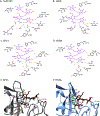Selective Recognition of Carbohydrate Antigens by Germline Antibodies Isolated from AID Knockout Mice
- PMID: 35282679
- PMCID: PMC10506689
- DOI: 10.1021/jacs.1c12745
Selective Recognition of Carbohydrate Antigens by Germline Antibodies Isolated from AID Knockout Mice
Abstract
Germline antibodies, the initial set of antibodies produced by the immune system, are critical for host defense, and information about their binding properties can be useful for designing vaccines, understanding the origins of autoantibodies, and developing monoclonal antibodies. Numerous studies have found that germline antibodies are polyreactive with malleable, flexible binding pockets. While insightful, it remains unclear how broadly this model applies, as there are many families of antibodies that have not yet been studied. In addition, the methods used to obtain germline antibodies typically rely on assumptions and do not work well for many antibodies. Herein, we present a distinct approach for isolating germline antibodies that involves immunizing activation-induced cytidine deaminase (AID) knockout mice. This strategy amplifies antigen-specific B cells, but somatic hypermutation does not occur because AID is absent. Using synthetic haptens, glycoproteins, and whole cells, we obtained germline antibodies to an assortment of clinically important tumor-associated carbohydrate antigens, including Lewis Y, the Tn antigen, sialyl Lewis C, and Lewis X (CD15/SSEA-1). Through glycan microarray profiling and cell binding, we demonstrate that all but one of these germline antibodies had high selectivity for their glycan targets. Using molecular dynamics simulations, we provide insights into the structural basis of glycan recognition. The results have important implications for designing carbohydrate-based vaccines, developing anti-glycan monoclonal antibodies, and understanding antibody evolution within the immune system.
Conflict of interest statement
The authors declare no competing financial interest.
Figures









Similar articles
-
Therapeutic Antibodies to Ganglioside GD2 Evolved from Highly Selective Germline Antibodies.Cell Rep. 2017 Aug 15;20(7):1681-1691. doi: 10.1016/j.celrep.2017.07.050. Cell Rep. 2017. PMID: 28813678 Free PMC article.
-
Glycan array analysis of the antigen repertoire targeted by tumor-binding antibodies.Bioorg Med Chem Lett. 2012 Nov 15;22(22):6839-43. doi: 10.1016/j.bmcl.2012.09.055. Epub 2012 Sep 24. Bioorg Med Chem Lett. 2012. PMID: 23063402 Free PMC article.
-
[Analysis of VH genes which encode the variable region of monoclonal antibodies directed to cancer-associated carbohydrate antigens].Gan To Kagaku Ryoho. 1989 Mar;16(3 Pt 2):662-79. Gan To Kagaku Ryoho. 1989. PMID: 2565104 Review. Japanese.
-
The Glycan Array Platform as a Tool to Identify Carbohydrate Antigens.Methods Mol Biol. 2015;1331:27-40. doi: 10.1007/978-1-4939-2874-3_3. Methods Mol Biol. 2015. PMID: 26169733 Free PMC article.
-
Early ovariectomy reveals the germline encoding of natural anti-A- and Tn-cross-reactive immunoglobulin M (IgM) arising from developmental O-GalNAc glycosylations. (Germline-encoded natural anti-A/Tn cross-reactive IgM).Cancer Med. 2017 Jul;6(7):1601-1613. doi: 10.1002/cam4.1079. Epub 2017 Jun 5. Cancer Med. 2017. PMID: 28580709 Free PMC article. Review.
Cited by
-
Application of bioanalytical and computational methods in decoding the roles of glycans in host-pathogen interactions.Curr Opin Chem Biol. 2023 Jun;74:102301. doi: 10.1016/j.cbpa.2023.102301. Epub 2023 Apr 18. Curr Opin Chem Biol. 2023. PMID: 37080155 Free PMC article. Review.
-
Anti-glycan monoclonal antibodies: Basic research and clinical applications.Curr Opin Chem Biol. 2023 Jun;74:102281. doi: 10.1016/j.cbpa.2023.102281. Epub 2023 Mar 9. Curr Opin Chem Biol. 2023. PMID: 36905763 Free PMC article. Review.
References
Publication types
MeSH terms
Substances
Grants and funding
LinkOut - more resources
Full Text Sources
Molecular Biology Databases

